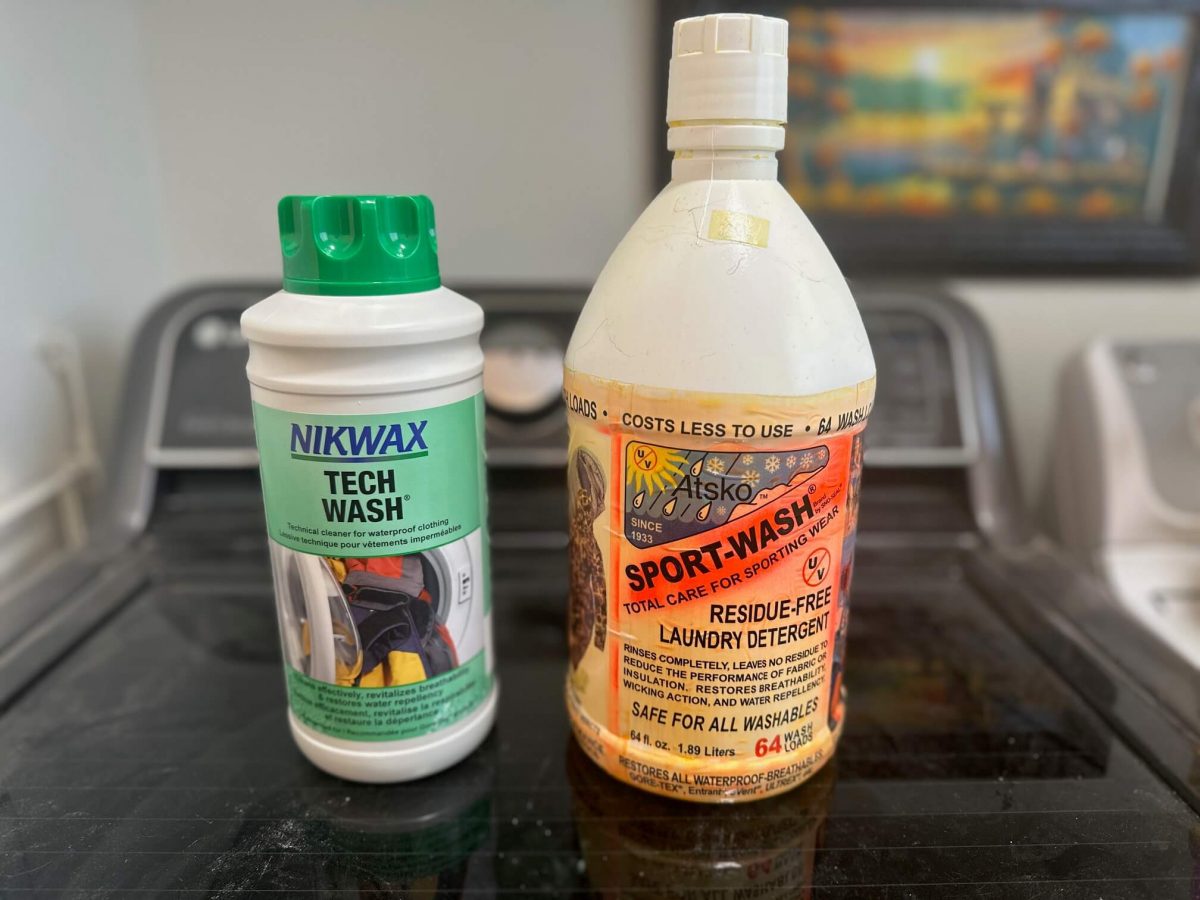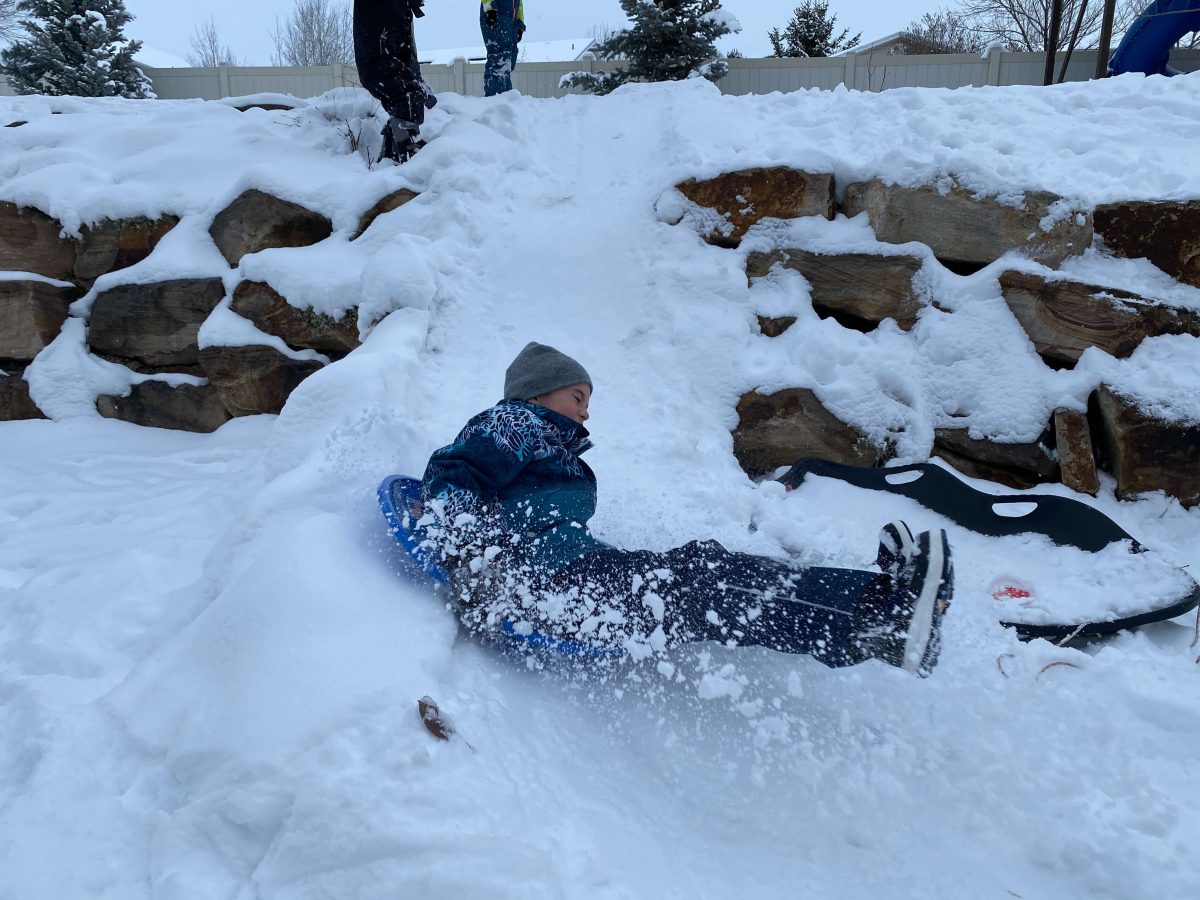This post may contain affiliate links where we earn from qualifying purchases. As an amazon associate, we earn from qualifying purchases. Find out more in our disclosure.
Keeping kids dry when you’re on an adventure outside is one of the best things that you can do to make sure that they’re happy and comfortable. As parents, we often focus on keeping kids warm, especially in the winter, but keeping them dry is just as important.
In a dream world, all kid’s outerwear would be incredibly waterproof and breathable and stay that way forever. In reality, nothing completely does. Even our favorite expensive kid’s outerwear eventually starts “wetting out” after a couple of seasons. Instead of constantly replacing your gear when the waterproofing is struggling, we’ll show you how to re-waterproof it instead!
Wetting Out: When water starts soaking into the fabric of your gear. This is a sign that the waterproof finish is failing.

Why Is My Kids Clothing Losing It’s Waterproofing?
One of the biggest reasons that any sort of gear with a waterproof coating on it loses its finish is because of dirt. Yes, dirt is the biggest culprit. The finish that’s on waterproof gear is hydrophobic, meaning that it repels water. Dirt is hydrophilic, meaning that it attracts water. The more dirt and oils (even just from the skin) that get onto your waterproof clothing, the less waterproof it becomes.

So if you want your waterproof gear to last as long as possible, you have to really work to keep it clean. We’ll go into detail below about how to wash waterproof gear (spoiler, it’s not with your regular laundry soap or other clothes), but just know that washing is SUPER IMPORTANT if you want your kid’s clothes to stay waterproof.
The other reason that kid’s clothing isn’t staying waterproof is that it wasn’t really waterproof in the first place. I’ve walked through plenty of big chain stores that have labels on boots and gloves that say waterproof, and I’m 100% certain that they’re not. If the gear is really waterproof, the manufacturer will share with you the waterproof rating. We recommend that all kid’s waterproof ratings be 10,000 or higher, though 7,500 will do for light use.
How To Clean Kids Outerwear
Before you take any steps towards waterproofing any of your kids gear, the first thing that you need to do is clean it. If it’s been a long time since you’ve done a good cleaning, or your kids outerwear is really dirty, I recommend washing twice.
I literally cannot stress enough how important it is to have your kids outerwear SUPER CLEAN before you try to waterproof it. It makes a world of difference in how well the waterproofing works.

We’re pretty diligent about maintaining our kid’s coats and snow pants throughout the winter, mostly because they represent a pretty major financial investment we’ve made AND they’re key to our family getting out on adventures in bad weather.
During the winter, we wash the kid’s outerwear at least once a month. If we do a big ski trip, where we’re skiing for a full week, I’ll usually wash it before and after the trip (ahem, I have 4 boys…stuff gets gross fast). For toddlers, we usually wash kids outerwear about every 2-3 weeks if we’re spending a lot of time outside since they tend to get dirty easier.

Kid’s outerwear should only be washed with other outerwear (not regular laundry), and only with special detergents. Regular detergent can leave behind residue that can impact the waterproofing of the garment. We recommend Sportwash or Nikwax Tech Wash. Typically, Sportwash is a better value (and works great), since you can use a much smaller amount to get your kid’s outerwear clean.
How Often Should Kids Gear Be Waterproofed?
As a general guideline, you should consider re-waterproofing your kids’ outdoor clothing at least once a season, or more frequently if you’re noticing that water isn’t beading up on the fabric anymore. Some telltale signs that it’s time to refresh the waterproofing are when you see water soaking into the material instead of rolling off, or if the clothing seems to get saturated and heavy during light rain or snow.

You know how crucial it is to make sure everyone’s comfortable when out and about. Wet, soggy clothing can quickly turn an awesome adventure into a miserable experience, and we definitely don’t want that for our little explorers.
Personally, I swear by doing a quick “water droplet test” after every few outings. I sprinkle a few droplets of water on the clothing and see how the fabric responds. If the water beads up and rolls off, you’re good to go. If it starts soaking in, it’s time for a refresh.
As a general rule, I re-waterproof gear about every 4-5 washes. If we’re using our gear a lot, then we refresh the waterproofing more. Generally for us, we waterproof gear in October and then again in February


Our favorite all around waterproofer, is TX Direct. It’s incredibly effective and you can just wash it in in the washing machine. This is the waterproof that we use most and is perfect for coats and snowpants!
Are There Waterproof Instructions Specific to My Brand?
Absolutely YES! Every brand has its own care instructions. Some recommend washing on delicate. Others on normal. Certain brands tell you to only hang dry your items, and others tell you to tumble dry on low.
Many brands will have their garment care instructions on the tag on the inside. If you don’t see care instructions, I ALWAYS recommend reaching out to the manufacturer before you clean and waterproof your outerwear. All fabrics are slightly different and the manufacturer will be able to tell you the best way to care for your pieces. Follow the manufacturer’s instructions FIRST and the instructions that we recommend SECOND.
How to Waterproof Kids Coats
Our kids’ coats take the biggest beating of all of our outerwear, so we clean and waterproof kids’ coats more than just about anything else. Above all else, follow the manufacturer’s instructions! Make sure to also empty all pockets and zip them back up.

Wash your kid’s coat with a good cleaner designed for outerwear. We’ve shared our favorite two outerwear cleaners above. After the wash cycle is DONE, leave the wet coat in the washing machine and wash it again with a wash-in waterproofer. Our preferred waterproofer for kid’s coats is Nikwax TX Direct. You wash it in when the coat is already wet, and the waterproofing gets everywhere it needs to be.

After that, put it in the dryer and tumble dry on low. The TX Direct actually works best when it has a little bit of heat added (but not a lot), so this actually helps with the process.
How to Waterproof Kids Snow Pants
Kids snow pant waterproofing is one area where I notice my kids clothes wetting out the fastest. Typically on the tops of their thighs (from sitting on a chairlift) or on their seat wet out the fastest. The way that we waterproof kids snow pants is very similar to how to waterproof kids coats.

Our kids often get dirty snowpants knees when playing outside on days where there isn’t a ton of snow. On those days, we spot-clean their pants with detergent and a rag, so we don’t have to wash a full load and to stretch out our time more between washes.
First of all, start by emptying out all the pockets and zipping them back up. Nce they’re empty, wash the children’s snow pants in an outerwear-safe detergent.
If you only need to waterproof one section of the snowpants, like the seat, you can get spray on TX direct. We occasionally use that, but find that overall, the wash in TX Direct waterproofing works just as good and is significantly easier.
Finally, tumble dry on low.
How to Waterproof Kids Gloves and Mittens
Gloves and mittens are probably our biggest culprit when it comes to kids outdoor gear wetting out. The real reason behind this is because lots of kids mittens and gloves are just not great quality. We’ve reviewed all of the best mittens and gloves for kids, if you need recommendations for a new pair. HINT: If your kids mittens or gloves start wetting out within the first few months of owning them, they’re not great quality, and we recommend getting a better pair.

How to Clean and Waterproof Kids Gloves and Mittens
Caring for and waterproofing gloves and mittens is a little different than other garments. For some people, they won’t need to wash or waterproof their gloves or mittens for a few years since they don’t wear them a lot. Our family spends A LOT of time outdoors, and especially while playing in the snow or skiing challenging terrain, we sweat quite a bit. Some of our kids have extra sweaty hands too. If you’re like us, we try to keep a good eye on how well things are drying, if they’re starting to stink, or if they’re wetting out too much.

The first thing that you need to do is to always dry your gloves and mittens before putting them away. You may not think this is a big deal, but putting your gloves away damp will significantly reduce their lifespan. We often just set ours up over a heating vent if we need them dry by the next day, or we use a glove dryer (check out the best glove dryers).
Next, when you do realize that they need to be re-waterproofed or when they’re starting to smell, it’s time to wash them. With gloves, more than any other type of gear, following the manufacturer’s instructions is critical. If you can’t find them, CALL! Depending on the glove or mitten, we’ll either handwash in the sink or throw them in the washing machine. Some of our kids mittens, like STONZ, have a liner that can be turned inside out which is amazing, so check to see if that works for your mittens for an extra thorough wash.
For leather gloves and mittens, we only hand wash them. Regardless of if you handwash your gloves or if you put them in the washing machine, only use a detergent that’s safe for outerwear products.
After your gloves or mittens are clean, it’s time to re-waterproof them. When we waterproof gloves, we always like to use Nikwax Glove Proof. It’s specifically designed to waterproof the material, but it’s also made so that it doesn’t impact the grip of the gloves at all. While technically, you could use something like TX Direct, we think that the gloveproof is easier and works better. To apply, make sure that the gloves are damp (this is perfect to do right after a wash), put your hand inside the glove (not required, but we think it makes it easier), and sponge the Glove Proof all over the outside. Let it soak in for a few minutes and then wipe the excess off. After that, dry the gloves fully before you use. You can tumble dry on low or air dry, but we typically just have gloves air dry.

If your gloves are primarily made of leather, instead of using Glove Proof all over, just use it on the fabric sections and waterproof the leather with this waterproofing wax.
How To Waterproof Snow Boots
Waterproofing snow boots is another gear item that requires special care and instructions. We rarely recommend washing boots in the washing machine. The rare exception to that is for boots that have removable liners that are specifically designed to be machine washed.

To wash snow boots, we find it easiest to wash them in the sink. Technically the bathtub works as well, but it does create a bigger mess since you’ll have to clean a full tub instead of a sink afterward. First of all, wash off any really dirty places. If your boots are lightly dirty a rag works for this, or if they have caked on dirt, we use a nylon brush to get the dirt off. Once they’re clean-er, we spray this footwear cleaner all over the boot. Be generous since the more you use, the better it works to really clean the boots. Rinse well.

After the boots are clean (but still damp), spray on this waterproofing spray. It works great on both fabric and leather boots. Wipe off any large drips, and let the boots air dry naturally. We typically will put the boots near a heating vent to dry slightly faster, but until the waterproofer is starting to dry, we keep a plastic bag underneath the boots in case there are any drips that we did not catch.

Lots of boots have a rubber bottom and those should never need to be waterproofed. That’s a big advantage of using a spray-on waterproofer for boots so that you can just waterproof the sections that need it.



